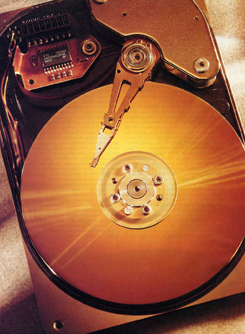Remember how large hard drives from a few years ago seemed? Remember how expensive they actually were? If Moore's Law tells us everything about the doubling of transistors every eighteen months or so, it at least partially explains the millenarian increase of magnetic platter storage capacity every decade. Ten years ago this April, a computer shopper could purchase hard drive space at one dollar a megabyte. Six years before that, a megabyte was worth fifty bucks. Today, it's a dollar for every gigabyte, something Glenn Reynolds noted yesterday as he marveled at the next metric leap for the consumer market, the terabyte.

I've quoted before from the relevant April 1994 article in PC Computing. Here it is in PDF format, entitled "Big Drives in Tiny Packages." The article's coauthors sandwiched two product roundups between their industry observations. One pits the contemporary top-of-the-line models against one another, the other mid-level performers. The price points - hold onto your hat - were $1000 and $500, respectively. My office has a clutch of old hard drives in our little computer junkyard: one 2GB, one 1GB and one 800MB. I don't think I could buy dinner at a bar-and-grill for their combined street prices.
Wisely, the coauthors were careful not to pontificate, disciplined in sticking to facts and product information - for the most part. Nobody can help themselves from making at least one or two conclusions on value, statements that draw knowing chuckles today. Statements like:
Pentiums galloping at 60MHz. Plenty of elbow room in 64MB of RAM. Sprawling vistas from local-bus video. Looks like the pieces for the ultimate desktop have finally come together...the Pentium, running at twice the speed of most 486 chips, gives weary disk drive developers no time to rest on their laurels.
How the world of technology does - and will continue to - change. Petabyte, anybody?